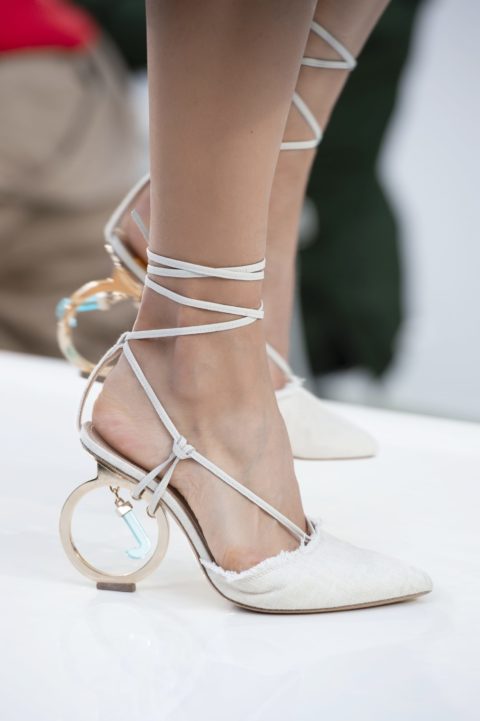Real High Heels Have Curves
The Spring 2019 runways were filled with high heels that had the countenance of a crescent moon. At Prada, they doubled as UFO spaceships, while at Jacquemus, feet were perched atop heels fashioned from perfect spheres. They were crafted into translucent points that looked like crystals at Balmain and dived inward like an exaggerated comma at Dior.
The predecessor of these contoured shapes is the Virgule, or “comma,” heel, created by Roger Vivier in 1963. Yet the trend of unusual heels can be traced back to the Dada movement of the 1930s, where they were often subverted. Artist Meret Oppenheim trussed two high heels together—the white stodgy kind worn by nurses—and displayed them belly up on a platter. The use of the heel as a “readymade”—a term coined by artist Marcel Duchamp to describe art made from manufactured objects—set a historical and artistic precedent for the unusual heel shapes we see today.
These sloped heels, with their bulbous curves that resemble Henry Moore sculptures, and stilettos serve a similar purpose: to make the wearer taller and accentuate the leg. But when the viewer’s eye travels down and reaches the heels, they’re in for a surprise. The tension between familiarity and the perversion of the shape throws the heels into flux, creating a feeling of the uncanny. They are surreal, mystical and distinctly feminine.
High heels have always telegraphed the power of the wearer, the foot precariously wrapped in bondage atop a rigid spike. The result is unanimously sexy. But these heels, with their undulating curves, signify a shift away from the phallic, Space Needle-esque architectural lines and toward shapes that hint at the voluptuous, organic female form—not unlike the sculpture Venus of Willendorf (carved between 24,000 and 22,000 BCE), which amplifies the reproductive female body. This return to the womanly form tracks nicely with fashion that has become less overtly sexualized (bandage dresses and stilettos) and more subtly suited to the female gaze (Phoebe Philo’s former work at Celine and clogs). In an essay on “ugly fashion” published in The Paris Review, Katy Kelleher writes: “Stiletto sandals reveal and pumps accentuate, but like the armadillo shoes, clogs obscure the shape of the feet. They remove all eroticism. There is no delicate arch, no pointed toe, just leather and wood and practicality.”
Heels that slope and curve like the Antelope Valley exist somewhere between the pragmatic nature of clogs and the impracticality of towering high heels.
Heels that slope and curve like the Antelope Valley exist somewhere between the pragmatic nature of clogs and the impracticality of towering high heels. They’re not exactly functional in the same way that kitten heels are, but they’re not treacherous either. They’re less a symbol of danger and sex and more quirky. A playful wink, the heels droop like a Dalí clock or an object out of a Dr. Seuss book.
These new shapes are perhaps the latest evolution of #heelconcept, an Instagram phenomenon pioneered by American artist and textile designer Misty Pollen that gained traction in 2015. The Dada-inspired trend involved users arching a bare foot on top of a Jenga block of household objects—everything from a sprouting potato to a scrub brush to a can of Pringles—to create imaginary heels that surprise and subvert. Soon after, the #heelconcept trend was absorbed into high fashion, appearing in the form of a lighter at Vetements, a plastic drinking cup at Margiela and a toy elephant at Dorateymur.
Similar to art, high heels don’t fill a pragmatic need as much as they do a superfluous one that imbues life with meaning—an aesthetic object that works to give pleasure to both the wearer and the watcher. What you make of them is up to you.
The post Real High Heels Have Curves appeared first on FASHION Magazine.



